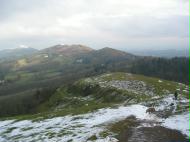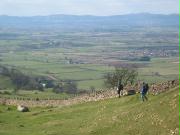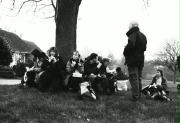
CYHA News
The Monthly Newsletter of Chelmsford YHA Local Group
April 2005
the joys of spring
Only a couple of weeks ago we were shivering in the snow and now the daffodils are in bloom, the frogs are getting restless and it's still light getting home from work. What better time to start thinking about your plans for the summer! Look inside our April issue and feast your eyes on early summer in Scotland, high summer in Wales and Norfolk, and late summer sampling the delights of Jersey. What more can you ask for?
Ali
The Malvern Enigma

A few weeks before our planned trip the Malvern Hills hostel, a mysterious package unexpectedly arrived in the post. I opened it and found a DVD. Not the latest blockbuster, but a 1962 black-and-white BBC documentary on the life of the composer Sir Edward Elgar (1857-1934). Also enclosed was a note from Lorna "You must watch the opening sequence…just watch the first 10 minutes…you must watch it!". So what was the connection?
For 55 of his 76 years, Elgar lived within sight of the Malvern Hills. This range of hills runs south from Great Malvern for about 9 miles. They were always a favourite haunt of Elgar's and he was often to be found walking, kite-flying, cycling or exercising his dogs on the Hills. Much of his music was inspired whilst walking in the hills. He composed many of his most famous works in Malvern - The 'Enigma' Variations, the Pomp and Circumstance March No.1 ("Land of Hope and Glory") and The Dream of Gerontius.
The film, directed by Ken Russell, includes some marvellous views of the landscape as the camera swoops and glides over Elgar's beloved hills.
Suitably inspired, we set out to walk the length of the ridge. We started near the southern end at Herefordshire Beacon, known as 'British Camp' because of the Iron Age earthworks at its summit. Here, according to legend, the British leader Caractacus fought the invading Roman army. It was this legend which inspired Elgar to write his cantata 'Caractacus'.
Although the highest point, Worcestershire Beacon, is only 1,395 feet above sea level, the hills stand alone in the surrounding plains and it is claimed that you can see seven counties. However, as we walked northwards the hills became snowier and mistier, and it was hard to believe we were less than a mile from the town centre.
Elgar once said "If ever after I'm dead you hear a little tune amongst the bracken on these Hills, don't be frightened as it will only be me humming the opening bars of my 'Cello Concerto". I think I heard something, but perhaps it was just Lorna humming?
Ian's recommended teashop at St. Ann's Wells was closed for refurbishment, so we headed into the town for tea and scones at what, they claimed, had been Elgar's favourite teashop.
For Saturday evening Ali made a huge cauldron of beef stew (sadly, history doesn't record whether Sir Edward liked beef stew), and Geli provided us with a splendid selection of home-made desserts.

Sunday was superbly clear and sunny, so most of us set out to walk from Elmley Castle to Bredon Hill. Not only did we get a panoramic view of the Malvern Hills, but fine views of the snow-covered Cotswolds, the Shropshire Hills 30 miles away, and more than 50 miles to Sugar Loaf and Skirrid in the Black Mountains of South Wales.
A few of us had the chance to stop in Worcester on the way home, for tea and cakes at the Cathedral, overlooked by a bronze statue of, of course, the walrus-moustached Sir Edward Elgar.
Dave P
Coggeshall - First walk of 2005

The first walk of 2005, in Coggeshall, saw a strong turnout and bright weather. We walked across the fields to Feering and had our sandwiches on the village green. We had intended to have a pub lunch, but two of the pubs didn't take bookings, and the third had lectured me about being let down by walkers before asking for a £40 deposit. We noted with some satisfaction that that pub was almost empty right through lunch time. We then returned to Coggeshall along the river via two old watermills, and the remains of the abbey. We finished by dividing ourselves between two tea shops, as we couldn't all fit in one.
Jim
Gosfield walk

A chilly but bright morning saw some 16 of us set out on a splendid walk around the peaceful rural setting of Gosfield in north Essex. Ten minutes into the walk we got a call from Graham, who mistakenly thought the walk started at 10.30. All was saved however, when we met up at the first pub at lunchtime. A jolly stroll through rolling hills, along quiet lanes & deer tracks and we completed our walk with time enough for pub number two. I'm sure the Ramblers would never stand for it.
Ali
New Zealand - the bits you can't show in a slide show!
As you may know, Dave and I recently spent three and a bit blissful weeks on the other side of the world, absorbing Kiwi culture and taking an obscene number of photographs (see planned slide show for 27th April). As with all such things, there are some experiences you simply can't represent in a photo.

One of these was our trip to Tamaki Maori village for a traditional Hangi. This started with a drive to the village in our Waka (in our case a 50 seater coach), being introduced to the other families making up our "tribe". On arrival we waited outside the village stockade for the challenge (Te Wero), involving a Maori warrior rolling his eyes and waving his spear at us to see if we were friendly. A representative from the Waka presented a peace offering to the warrior, before one of the Maori women sang the "Karanga" and we were welcomed inside the village. Passing through the stockade of tree trunks, we saw a village made up of low huts with elaborately carved figureheads and filled with Maoris in traditional dress (somewhat out-numbered by the visitors, it's true). Our destination was The Big House (or Wharenui) where we were treated to a display of manual dexterity involving balls on strings and sticks, songs and dances and a demonstration of traditional musical instruments. Then came bit that Dave enjoyed the most, the hangi - an all you can eat feast baked in the traditional manner (a pit oven fuelled by rocks heated to white hot).

The closing ceremony was perhaps the most touching. This had our coach drivers performing a haka with great gusto, rolling their eyes and trying to scare the children. The version you see at the rugby is a bit pathetic by comparison. It all made for a very memorable evening.
The other experience to relate is our visit to the Waitomo caves, where photography is actually banned. Last year I managed to persuade Dave to crawl around Danbury Common in search of English glow worms. Our ardent searching was rewarded by the discovery of 4 individuals glowing brightly like a green LED. The glow worms in New Zealand are a different species, a skinny brown maggot rather than our woodlouse-like beetle, but the glow is very similar. The thing that makes Waitomo so spectacular is the shear number of them. You enter the cave on foot, but deep inside you change your mode of transport to a large open boat, which your guide propels using a pole and guide ropes. Sitting back you look up in the darkness of the cave to see something resembling a star-studded night sky. Every star is a little glow worm, shining to attract its dinner. And there are hundreds.
Ali
Barbara Rich visit to Malvern
Some of you will know that Barbara Rich, from the YHA, visited us at Malvern hostel on Saturday 26 February, and that I spent about an hour with her. Barbara actually works for the Inland Revenue, and has been seconded, with two other people to work for YHA for a year. Their aim is to act as liaison between YHA and the local groups, and to prepare a report on the future of local groups' relationship with YHA. Barbara's patch is southern England. There is currently no plan to replace them.
Barbara and I discussed the following:
- The YHA local groups' conference which took place in Oxford on 19-20 February.
- Proposed hostel closures including Badby. This was raised, passionately, at the conference. Badby will close anyway. YHA has a set of 5 criteria on which it judges hostels for closure, including turn-over, and cost to bring a hostel up to government / European standards. I expressed the sentiment that YHA seems to be closing hostels where people want to go, e.g. 3/4 Cotswolds hostels, while opening hostels where they can get a subsidised building from a local authority or similar, in areas where people may not want to go.
- YHA is considering helping local groups with publicity, such as providing better web links from their site to local groups, and putting a local groups list in a new member's joining pack, although there's nothing concrete. I commented that they don't seem to help much with publicity as it is, and did things like removing the local groups' list from the hostel manual. I observed that we are doing well enough with our own publicity, such as the web-site, and our advert in Country Walking, despite the YHA.
- YHA are considering asking local groups for an annual report. I said that I would be unhappy about this, as it is an extra administrative burden, and I didn't see the point.
- YHA are considering asking local groups to fundraise or volunteer, and would chase groups up. Barbara pointed out that our Saffron Walden and Jordans work was plenty enough to meet this. I took great exception to this idea, and said as much. We provide a good source of bed nights and new memberships as it is.
- YHA is split into two parts; a charitable association, and a limited company. Changes in the Charity Commission rules, will force the YHA to transfer its operations from the association to the limited company. I don't think this will impact us.
- YHA is considering changing its insurance company, which could confuse things, since we'd only just clarified our current situation.
JIM
Please send any comments on these pages to Dave Plummer